Pentapora Fascialis Worms
MarLIN
The Marine Life Information Network
information on the biology of species and the ecology of habitats found around the coasts and seas of the British Isles
Listed species
Listed habitats
Sensitivity assessment method
Sensitivities
Evidence based resources and tools
- Home
- Species list
- Ross (Pentapora foliacea)
Ross (Pentapora foliacea)
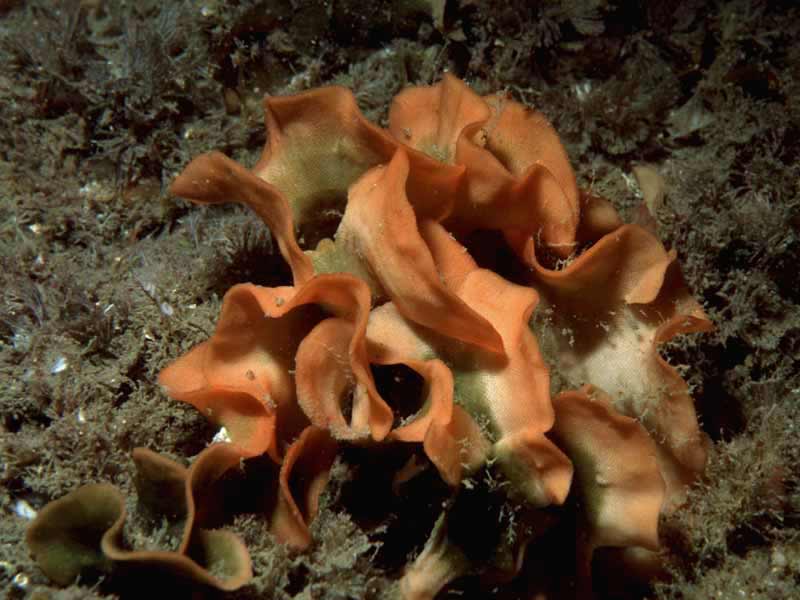
Small colony of Pentapora fascialis.
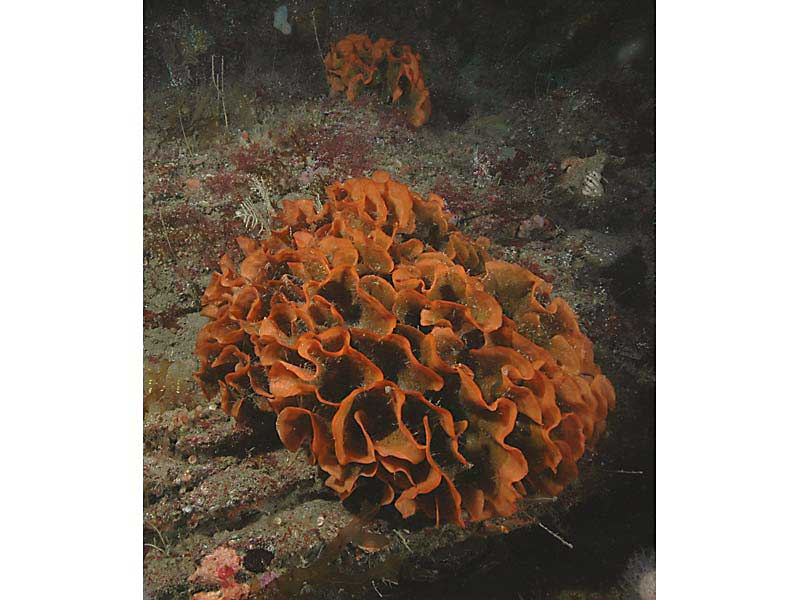
Pentapora fascialis colonies on rock at the Mewstone, Plymouth.
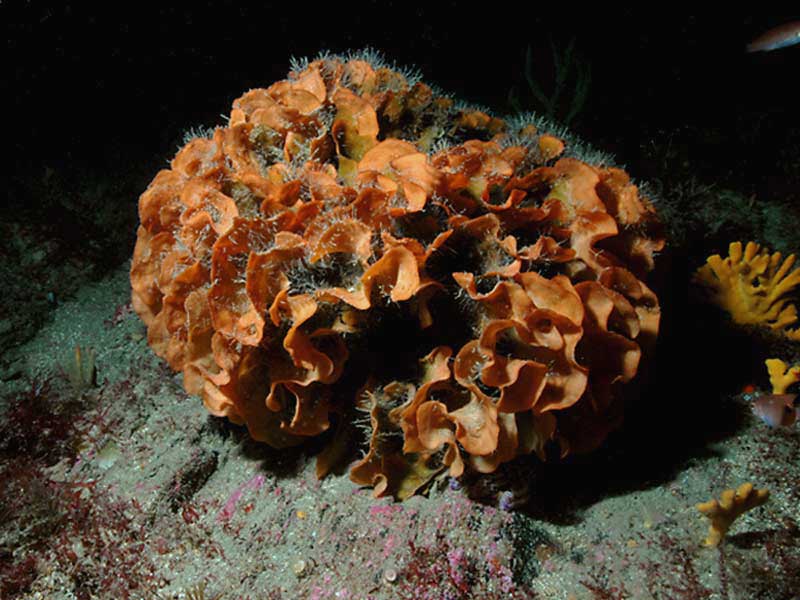
Pentapora fascialis colony at the Mewstone, Plymouth.
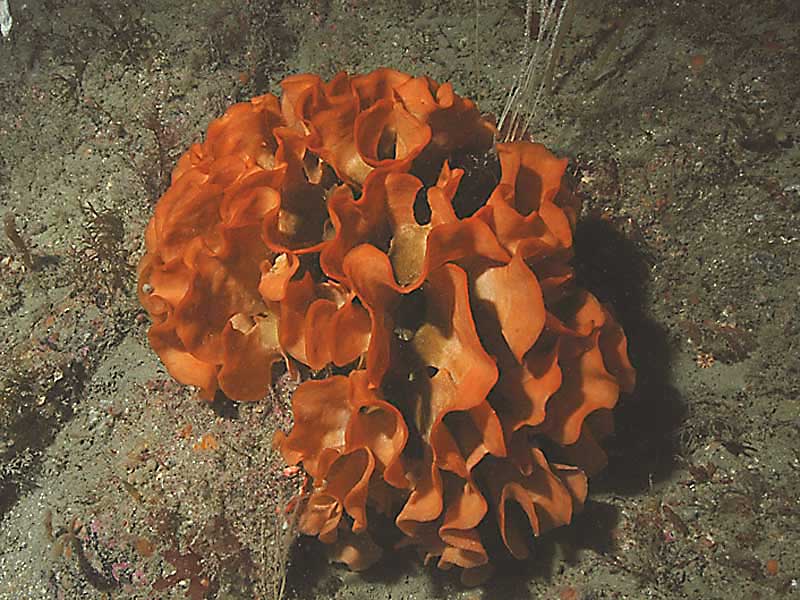
Pentapora fascialis colony on the Mewstone, Plymouth.
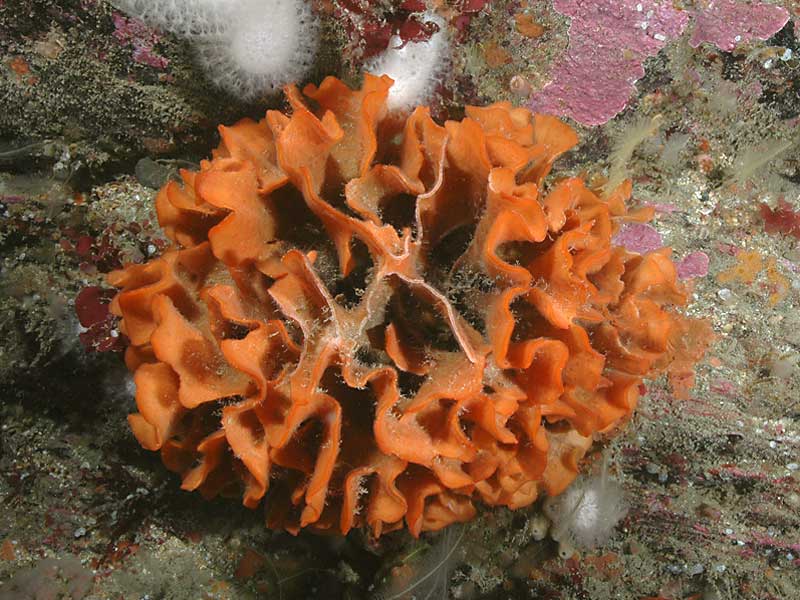
Pentapora fascialis with tips at the middle of the colony sloughed off, on the Mewstone, Plymouth.
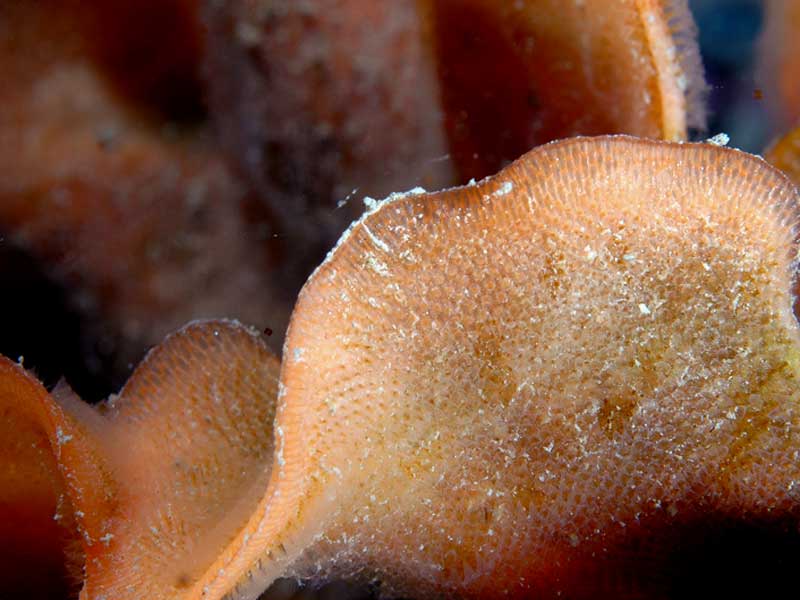
Close up of Pentapora fascialis on the Mewstone, Plymouth.
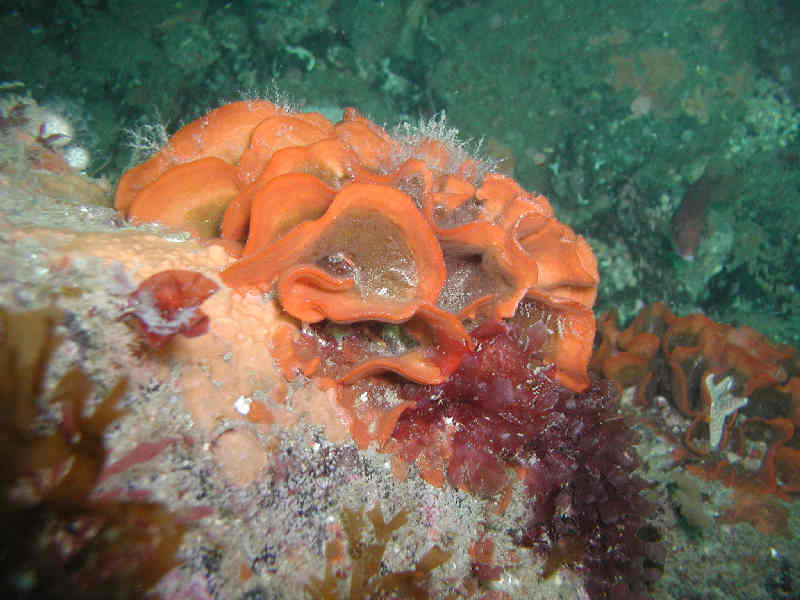
Ross (Pentapora fascialis).
Photographer: Paul Newland  Copyright: Paul Newland
Dr Peter J. Hayward
(Ellis & Solander, 1786)
Pentapora fascialis (Pallas 1766), Lepralia foliacea (Ellis & Solander, 1786)
Description
A large, erect bryozoan deep orange in colour. The colony is attached to the substratum by an encrusting base and forms a mass of repeatedly dividing sheets in an open honeycomb structure. The edges of the sheets are wavy and convoluted. Pentapora foliacea has a growth rate of approximately 2 cm per year and lives for up to ten years. Colonies can reach up to 40 cm in diameter (more typically up to 20 cm across) and 10 cm in height. When dead, the deep orange colour fades to a pale buff.
Recorded distribution in Britain and Ireland
Common along the South coast of England as far east as Beachy Head. Also the south west, the western extremities of Wales and the Isle of Man. In Ireland present along the south west and north coasts. Scarce records from the Hebrides and St Kilda.
Global distribution
Pentapora foliacea is also recorded from the north coast of Morocco, but Mediterranean records require reassessment based on recent taxonomy (Lombardi et al., 2010).
Pentapora foliacea colonies grow on bedrock or large boulders in current swept areas, often surrounded by gravel and scoured by coarse sand. They may colonize coarse gravel and pebbles but do not grow to large colonies.
Depth range
Identifying features
- Colonies erect, forming orange-buff clumps up to about 15 cm across.
- Young zooids elongate-hexagonal, with scattered pores in frontal wall.
- Frontal wall covered with heavy additional calcification, outline becoming rectangular or broadly hexagonal.
Additional information
Sometimes misleadingly called “ross coral”. The Species Directory of the British Isles (Howson & Picton, 1997) placed Pentapora fascialis in the family Hippoporinidae under the species name Pentapora foliacea but Hayward & Ryland (1999) conflated the species and suggested that P. foliacea was a junior synonym of P. fascialis (Lombardi et al., 2010). Older classification schemes used the species Lepralia foliacea, e.g. the Plymouth Marine Fauna (Marine Biological Association 1957) and Bruce et al. (1963). But a recent study by Lombardi et al. (2010) concluded that Pentapora foliacea and Pentpora fascialis were distinct species and that P. foliacea was the resident species in the North East Atlantic while P. fascialis was included in the Mediterranean clade.
Due to the lack of information on these species and the taxonomic confusion in the literature, this review is based on information on both Pentapora foliacea and P. fascialis.
Further information sources
Biology review
A variety of bryozoan species, and other epibionts.
Biology information
- Densities in the Bristol Channel have been recorded as up to one large colony per square metre. Populations in the Mediterranean have been recorded at densities of up to 7 colonies per square metre.
- Pentapora fascialis grows initially as an encrusting sheet, which seems able to regenerate erect growths (P.J. Hayward pers. comm.).
- Size ranges refer to colony diameter. Colony size is typically up to 20 cm in diameter and large specimens reach 40 cm across. The largest recorded specimen was from the Eddystone Light and had a circumference of over 2 metres and a depth of 30 cm (Hayward & Ryland, 1979). Specimens of Pentapora fascialis in the Mediterranean reach larger sizes (80cm diameter, 50 cm in height) in deeper waters (40-80 m).
- Colony shape has been described as ‘depressed globular’ or ‘dome-like’ with an elliptical perimeter (Cocito et al., 1998(a)). Growth rates in the Bristol Channel have been estimated at around 2 cm (vertical height) per year through the use of stable oxygen isotope values (Patzold et al., 1987.). Another growth rate estimate (from the Mediterranean) indicates growth of over 200% colony surface area in 11 months (Cocito et al., 1998). Vertical growth has been recorded at up to 3.5 cm per year (Cocito & Ferdeghini, 1998 cited in Cocito et al., 1998).
- The calcified laminae are rather brittle.
- Pentapora fascialis characteristically supports several bryozoans including Amphiblestrum flemingii, Callopora dumerilii, Membranipora nitida & Smittoidea reticulata (Hayward & Ryland, 1979). Large colonies may shelter 1000’s of other animals (Hayward & Ryland, 1979).
Habitat preferences
No text entered
Habitat Information
Off Lundy in the Bristol Channel, most common below 18 m and abundant between 25 -34 m (Hayward & Ryland, 1979). Pentapora fascialis is recorded as settling on artificial substrata in the Ligurian sea (Geraci, 1974 cited in Cocito et al., 1998(b)). Pentapora foliacea is recorded as being present (off the British Isles) in temperatures between 8 & 14 °C and salinity of 34.5 psu (Patzold et al., 1987).
Life history
Adult characteristics
Larval characteristics
Importance information
On rocky, current swept seabeds, the species is often a conspicuous and dominant component of the assemblage (Hayward & Ryland, 1979.). Pentapora foliacea is recorded as acting as host for a variety of other bryozoan species and shelter for quite high densities of other fauna (Hayward & Ryland, 1979)
Bibliography
Bruce, J.R., Colman, J.S. & Jones, N.S., 1963. Marine fauna of the Isle of Man. Liverpool: Liverpool University Press.
Cocito, S., Ferdeghini, F., & Sgorbini, S., 1998b. Pentapora fascialis (Pallas) [Cheilostomata: Ascophora] colonization of one sublittoral rocky site after sea-storm in the northwest Mediterranean. Hydrobiologia, 375/376, 59-66.
Cocito, S., Sgarbini, S. & Bianchi, C.N., 1998a. Aspects of the biology of the bryozoan Pentapora fascialis in the northwestern Mediterranean. Marine Biology, 131, 73-82.
Eggleston, D., 1972a. Patterns of reproduction in marine Ectoprocta off the Isle of Man. Journal of Natural History, 6, 31-38.
Gautier, Y.V., 1962. Recherches ecologiques sur les bryozoares chilostomes en Mediterranee occidentale. Recueil des travaux de la station marine d’Endoume, 38, 165-166.
Hayward, P., Nelson-Smith, T. & Shields, C. 1996. Collins pocket guide. Sea shore of Britain and northern Europe. London: HarperCollins.
Hayward, P.J. & Ryland, J.S. 1979. British ascophoran bryozoans. London: Academic Press.
Hayward, P.J. & Ryland, J.S. 1999. Cheilostomatous Bryozoa. Part II Hippothooidea – Celleporoidea. London: Academic Press.[Synopses of the British Fauna, no. 14. (2nd edition)]
Howson, C.M. & Picton, B.E., 1997. The species directory of the marine fauna and flora of the British Isles and surrounding seas. Belfast: Ulster Museum. [Ulster Museum publication, no. 276.]
JNCC (Joint Nature Conservation Committee), 1999. Marine Environment Resource Mapping And Information Database (MERMAID): Marine Nature Conservation Review Survey Database. [on-line] http://www.jncc.gov.uk/mermaid
Keough, M.J. & Chernoff, H., 1987. Dispersal and population variation in the bryozoan Bugula neritina. Ecology, 68, 199 – 210.
Lock, K., Burton, M., Luddington, L. & Newman, P., 2006. Skomer Marine Nature Reserve project status report 2005/06. CCW Regional Report CCW/WW/05/9., Countryside Council for Wales.
Lombardi, C., Taylor, P.D. & Cocito, S., 2010. Systematics of the Miocene–Recent bryozoan genus Pentapora (Cheilostomata). Zoological Journal of the Linnean Society, 160 (1), 17-39. DOI: 10.1111/j.1096-3642.2009.00594.x
MBA (Marine Biological Association), 1957. Plymouth Marine Fauna. Plymouth: Marine Biological Association of the United Kingdom.
Patzold, J., Ristedt, H. & Wefer, G., 1987. Rate of growth and longevity of a large colony of Pentapora foliacea (Bryozoa) recorded in their oxygen isotope profiles. Marine Biology, 96, 535-538.
Picton, B.E. & Costello, M.J., 1998. BioMar biotope viewer: a guide to marine habitats, fauna and flora of Britain and Ireland. [CD-ROM] Environmental Sciences Unit, Trinity College, Dublin., http://www.itsligo.ie/biomar/
Sala, E., Garrabon, J. & Zabala, M., 1996. Effects of diver frequentation on Mediterranean sublittoral populations of the bryozoan Pentapora fascialis. Marine Biology, 126, 451-459.
This review can be cited as:
Last Updated: 08/06/2016
Marine Life Information Network (MarLIN), The Marine Biological Association of the UK (see contact us)
© 2018 The Marine Biological Association of the UK, All Rights Reserved.



